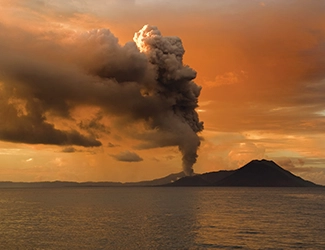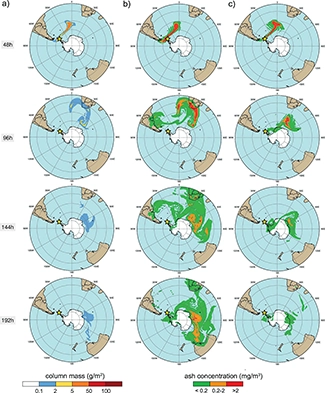Dealing with volcanic ash
This invisible hazard to aviation can affect aircraft anywhere and at any altitude.
By Karsten Shein
Comm-Inst
Climate Scientist

Crossing northern Canada at FL350, the crew was enjoying an idle conversation while the autopilot kept them on course. The occasional glance out the windscreen revealed nothing but empty sky. Looking at the panel, however, the copilot noticed that the exhaust gas temperature (EGT) on the right engine had increased, and she noticed a subtle smoky smell.
As she pointed it out, the engine began to surge. It flamed out within seconds. Just after beginning the restart process, the left engine followed suit. Descending rapidly, the pilots attempted to restart the engines repeatedly, finally managing to restart one engine at 12,000 ft.
After an emergency landing at YZF (Yellowknife NT, Canada), the pilots found the fan blades were coated with what looked like rough cement, while the nose of the transcontinental business jet had been stripped of most of its paint. They knew then that they had encountered volcanic ash from the ongoing eruption of a volcano in Alaska.
Ash is any solidified magma or pulverized rock less than 2 mm in diameter produced as the violent expansion of the volcanic gases destroys the overlying rock or disintegrates the liquid magma, which cools rapidly. In a large eruption, ash can be lofted more than 40 km (approx 25 miles) into the atmosphere, although much of the ash will be entrained in the troposphere and carried by the prevailing winds aloft, frequently in the cruising altitudes of jet aircraft.
Dangers to aviation
The problems aviation faces from ash stem from its chemical and physical properties. A flight through an ash plume will act as a sandblaster, stripping paint and abrading exposed surfaces, such as windscreens, propellers, or fan blades. It may also cause electrostatic interference with communications.
Chemically, volcanic ash can be extremely corrosive, often producing sulfur dioxide and sulfuric acid when mixed with water or accumulated on aircraft. Aircraft on the ground downwind from an eruption, even if hangared, should be cleaned frequently to prevent corrosion. Engines should be dry cranked to ventilate them before startup.
However, the most dangerous properties of ash are its size and its low melting point (around 1100° C). An object less than 2 mm in diameter (and a lot of ash is microscopic) can enter the cabin easily through air inlets, causing breathing problems. It can also become lodged in pitot tubes or other ports, making altitude and airspeed readings unreliable. Ash has been known to contaminate fuel. And, if it’s ingested into an engine, it can clog air intakes, jam gears, and even melt in the combustion chamber, clogging fuel injectors and adhering to turbine blades and guide vanes.
When ash clogs gas flow through the nozzle guide vanes, fuel delivery to the turbine is decreased, making gas flow reverse, causing a compressor surge that may result in a flame-out. With the rapid cooling of the engine following a flame-out, any molten ash will resolidify. However, depending on the degree of obstruction, gas pressure should begin to dissipate from the engine core, returning normal (although restricted) flow required to restart the engine – hopefully with sufficient altitude for recovery. Ironically, the loss of altitude will often remove the aircraft from the ash cloud, preventing further ingestion of ash.

Volcanic ash advisories
Recognizing the threat to aircraft, ICAO established 9 Volcanic Ash Advisory Centers (VAACs) in 1991. VAACs are responsible for monitoring volcanic activity worldwide and improving forecasts of ash hazards. When an area of volcanic ash is identified, the responsible VAAC will issue a Volcanic Ash Advisory (VAA), which is disseminated to pilots as a NOTAM or SIGMET via ATC, company network operations centers (NOCs), or weather services.
Heeding VAAs is important because they define areas of ash concentration that present dangers to aircraft, and that concentration is frequently too low for an ash cloud to be seen by a pilot from the cockpit. In many ash encounters, pilots have reported seeing a clear or slightly hazy discolored sky ahead of them. If a pilot can see an ash cloud, the ash concentration is almost certainly a danger.
While there are roughly 1350 active volcanoes around the world, they are mostly concentrated along the edges of the crustal plates, such as the so-called “Ring of Fire” around the Pacific Plate. The real danger is that once the ash is lifted into the flight levels, strong winds can spread it thousands of miles downwind. In some cases, the cloud may circle the Earth. In other cases, a long-lived eruption may spread ash across a large area, such as happened in 2010 when Eyjafjöll’s ash cloud limited or closed much of European airspace, resulting in almost $2 billion in damage to the aviation industry.
VAAs are not perfect, and ash may be present in a broader area or wider altitude range than forecast. A pilot entering an ash cloud may first notice an acrid smell similar to an electrical fire or natural gas leak. Airspeed may decrease, and fire warnings may activate. Following those indications, the engines may begin to show malfunction, such as an increase in EGT, surging, or even flame-out. Critically, although some experimental ash detection avionics are being tested, normal airborne weather radars will not show ash.
Ash encounters
At the first indication of ash, pilots should try to exit the cloud. The best course of action is to make an immediate 180° turn and disconnect autothrottle. Climbing is not advised, as thrust should be reduced (if able) to mitigate the risk of melted ash depositing in the turbine chamber, and airspeed readings may be unreliable. Also, pilots (and passengers) should don oxygen masks, as ash can penetrate the cabin and inhaling the toxic and abrasive ash can quickly cause respiratory problems – even in small amounts.
Compressor surges and flame-outs may be reduced by increasing bleed demand, and starting the APU can provide electrical power should a flame-out occur. Monitor all engine indicators closely, and take appropriate measures if they begin to change unexpectedly. Refer to GPS altitude and airspeed readings if available, as pressure-based readings may be unreliable. As soon as practical, plan to land at a suitable nearby airport, and report the encounter to ATC as a Volcanic Activity Report (VAR).
Once landed, a thorough inspection of the aircraft is a must before it can be considered airworthy. At the minimum, air filters will need to be replaced, and pitot-static ports and other air inlets must be cleared. Depending on the amount of time spent in the ash cloud and the severity of the impact on the aircraft, complete engine overhauls or replacements are not uncommon.
The best way to avoid encountering an ash cloud is to give any volcanic SIGMET areas a wide margin of error horizontally and vertically. With a proper weather briefing and a review of current VAAC products, pilots should be able to avoid areas where volcanic ash may be present.
 Karsten Shein is cofounder of 2DegreesC.org. He was director of the Midwestern Regional Climate Center at the University of Illinois, and a NOAA and NASA climatologist. Shein holds a comm-inst pilot license.
Karsten Shein is cofounder of 2DegreesC.org. He was director of the Midwestern Regional Climate Center at the University of Illinois, and a NOAA and NASA climatologist. Shein holds a comm-inst pilot license.